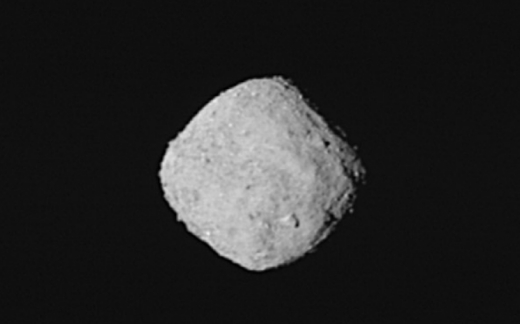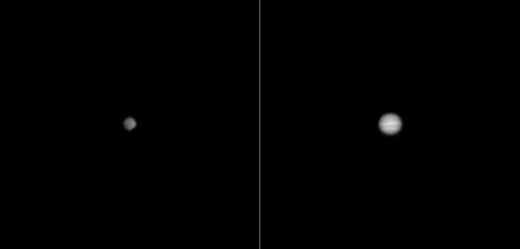Following a week when we learned of the end of both Kepler and Dawn, let’s turn to a mission that is just coming into its own. The earliest images of target asteroid 101955 Bennu from OSIRIS-REx have been tightened by computer algorithm to heighten their resolution. The mission plan here is to examine the small object (approximately 500 meters in mean diameter) and return samples to Earth in 2023.
More than a few people have reacted to the similarity in shape between this asteroid, a carbonaceous (C-type) Earth-crossing object in the Apollo group of near-Earth asteroids, and 162173 Ryugu, now under active exploration by the Japanese Hayabusa2 mission. Here we’re looking at Bennu through the OSIRIS-REx PolyCam, one of three cameras aboard the spacecraft, from a distance of 330 kilometers. The image is a combination of eight images taken by PolyCam that have been combined to cancel out the asteroid’s rotation and produce a high-resolution result.
Of the comparison to Ryugu, Julia de León (Instituto de Astrofísica de Canarias – IAC) says this:
“The fact that the Japanese mission has reached its target a little ahead of us turns out to be extremely interesting, as we can now interpret our results and compare to the results obtained by another mission almost on real time.”

Image: This “super-resolution” view of asteroid Bennu was created using eight images obtained by NASA’s OSIRIS-REx spacecraft on Oct. 29, 2018 from a distance of about 330 km. The spacecraft was moving as it captured the images with the PolyCam camera, and Bennu rotated 1.2 degrees during the nearly one minute that elapsed between the first and the last snapshot. The team used a super-resolution algorithm to combine the eight images and produce a higher resolution view of the asteroid. Bennu occupies about 100 pixels and is oriented with its north pole at the top of the image. Date Taken: Oct. 29, 2018. Instrument Used: OCAMS (PolyCam). Credit: NASA/Goddard/University of Arizona.
The team from the IAC, which functions as part of the Image Processing Working Group (IPWG) for the OSIRIS-REx mission, is examining the early imagery from Bennu as an initial step in calibrations for comparison with later, higher-resolution images taken with color filters. In December, images from the spacecraft’s MapCam will begin coming in, putting those filters to work. The color maps thus generated will be used to break down the geographical distribution of silicates and other materials on the asteroid. And, of course, they will also play into the selection of a landing site from which a sample will be collected and returned to Earth.
OSIRIS-REx executed its third asteroid approach maneuver (AAM-3) on October 29, a set of thruster burns designed to slow the craft relative to Bennu from approximately 5.2 m/sec to .11 m/sec. The maneuver, verified by tracking data and telemetry, was designed to maximize the collection of high-resolution images as the spacecraft closes on the target. Another burn, the fourth in a series that began on October 1, will be executed on November 12, adjusting the craft’s trajectory for arrival at a position some 20 kilometers from Bennu on December 3.
And here’s another interesting image, a look at both Bennu and Jupiter, as seen by the OSIRIS-REx Polycam. The shot of Bennu was taken on October 22 of this year, with Bennu some 3,650 kilometers away, while the Jupiter image was captured on February 12, 2017 at a distance of 673 million kilometers. Notice the clear spherical shape of Jupiter as compared to the diamond-shaped Bennu, a shape predicted by ground-based radar observations.

Image: When these images were taken, Bennu was about five times closer to the Sun than Jupiter was, so the asteroid was receiving significantly more sunlight. If Bennu and Jupiter were equally reflective, the asteroid would appear about 25 times brighter in this image due to its proximity to the Sun. But Bennu’s surface is so dark (only reflecting about 3 to 4 percent of the incoming sunlight) that it appears darker than Jupiter despite being much closer to the Sun. Credit: NASA/Goddard/University of Arizona.
Carbonaceous C-type asteroids, as the image makes clear in this case, are low in albedo, presumably because of the large amount of carbon mixing with surface rocks and minerals.
If you’re tracking this mission closely, be aware of email updates that are available and check Twitter @OSIRISREx, Instagram or Facebook for more.
How many times is too many times to ask #AreWeThereYet on a single trip? Asking for a friend (who is now only a couple hundred kilometers from #asteroid Bennu)…
More on my whereabouts: https://t.co/rACre4nDe4 pic.twitter.com/tJaMcHw6qP
— NASA's OSIRIS-REx (@OSIRISREx) November 5, 2018



“More than a few people have reacted to the similarity in shape between this asteroid, a carbonaceous (C-type) Earth-crossing object in the Apollo group of near-Earth asteroids, and 162173 Ryugu”
Yes I was one of those people, in fact I would assume most if not all small asteroids to be very similar in appearance.
Can you briefly explain why?
Indeed, smaller asteroids were thought to be irregular.
And the flyby of somewhat larger ones by several spaceprobes enroute to other destinations, suggested so also.
The question is if Bennu and Ryugu are piles of loose rocks and gravel, if such get small impacts the material, together with their rotation, might very well be redistributed like this.
It might also be similar to a process known as sintering, though the temperature and timescale is very different. You sometime do get particles that have a diamond shape with rounded corners.
But any expert on material science here is absolutely free to correct me on that assumption. :)
Planetoid 2867 Steins, imaged by Rosetta in September of 2008, is also roughly diamond shaped:
https://en.wikipedia.org/wiki/2867_Šteins
It is an E-type planetoid with a diameter of approximately 4.6 kilometers.
Yes it do, but also a bit different. And that could suggest the ersatz sintering hypethesis as such particles comes out in somewhat different shapes.
Possible Earth impact[edit]
On average, an asteroid with a diameter of 500 m (1,600 ft; 0.31 mi) can be expected to impact Earth about every 130,000 years or so.[24] A 2010 dynamical study by Andrea Milani and collaborators predicted a series of eight potential Earth impacts by Bennu between 2169 and 2199. The cumulative probability of impact is dependent on physical properties of Bennu that were poorly known at the time, but was not found to exceed 0.071% for all eight encounters.[25] The authors recognized that an accurate assessment of 101955 Bennu’s probability of Earth impact would require a detailed shape model and additional observations (either from the ground or from spacecraft visiting the object) to determine the magnitude and direction of the Yarkovsky effect.
The publication of the shape model and of astrometry based on radar observations obtained in 1999, 2005, and 2011,[4] made possible an improved estimate of the Yarkovsky acceleration and a revised assessment of the impact probability. The current (as of 2014) best estimate of the impact probability is a cumulative probability of 0.037% in the interval 2175 to 2196.[6] This corresponds to a cumulative score on the Palermo scale of ?1.71. If an impact were to occur, the expected kinetic energy associated with the collision would be 1,200 megatons in TNT equivalent.[5]
2060[edit]
Bennu will pass 0.005 au (750,000 km; 460,000 mi) from Earth on 23 September 2060.[2] The close approach of 2060 causes divergence in the close approach of 2135. On 25 September 2135 the nominal approach distance is 0.002 au (300,000 km; 190,000 mi) from Earth, but Bennu could pass as close as 0.0007 au (100,000 km; 65,000 mi).[2] There is no chance of an Earth impact in 2135.[26][5] The 2135 approach will create many lines of variations and Bennu may pass through a gravitational keyhole during the 2135 passage which could create an impact scenario at a future encounter. The keyholes are all less than 55 km wide.[6]
On 25 September 2175 there is a 1 in 24,000 chance of an Earth impact,[5] but the nominal 2175 approach is in February 2175 at a distance of roughly 0.1 au (15,000,000 km; 9,300,000 mi).[2] The most threatening virtual impactor is on 24 September 2196 when there is a 1 in 11,000 chance of an Earth impact.[5] There is a cumulative 1 in 2,700 chance of an Earth impact between 2175–2199.[5]
Long term[edit]
Lauretta et al. reported in 2015 their results of a computer simulation, concluding that it is more likely that 101955 Bennu will be destroyed by some other cause
The cuboidal (or perhaps quasi-faceted) look of both is interesting.
Michael
Charcoal briquettes?
Forgive my ignorance but I still don’t understand the shape. Is it on its way to becoming a sphere if it were to grow in size? I see no obvious reason for this shape to be preferred otherwise.
These rubble pile asteroids tend to take on these shapes due to rotation (centripetal “force” greatest at the equator, zero at the poles) and their overall weak surface gravity due to low mass. Over time lose rocks and boulders will tend to roll toward the equator whenever there is disruption such as when an impact occurs.
Bruce
So if the “sides” are the result of the equivalent of the local “angle of repose”, why the facets, rather than 2 cones?
Are we sure that they have flat faced “facets” and not 2 cones with polar peaks? A time-laps of their rotations should settle this quickly. I’ll be the first to abandon my simple rotational explanation if they really are fully diamond shaped and look that way from the poles also.
Bruce
Arthur C. Clarke predicted that Jupiter has the Diamond core inside.
So there is big chance that Bennu asteroid in reality is mostly huge Diamond (covered by some ice and dust)…
May be this is the good explanation why there is so big interest to diamond shaped asteroids :-)
May be we are witnesses of a beginning of new “Gold Fever” in space …
Huge crystall of diamond :-)
https://apod.nasa.gov/apod/ap181113.html
Rotating Asteroid Bennu from OSIRIS-REx
Image Credit: NASA, GSFC, U. Arizona
Explanation: Could this close-by asteroid ever hit the Earth? Eventually yes — but probably not for a very long time, even though the asteroid is expected to pass inside the orbit of the Moon next century.
However, to better understand the nature and orbit of all near-Earth asteroids, NASA sent the robotic Origins, Spectral Interpretation, Resource Identification, Security, Regolith Explorer (OSIRIS-REx) to investigate this one: the 500-meter across asteroid 101955 Bennu.
Launched in 2016, OSIRIS-REx is now approaching Bennu, and is first scheduled to map the minor planet’s rough surface. The featured time-lapse video taken earlier this month compacts Bennu’s 4.25-hour rotation period into about 7 seconds.
Bennu’s diamond-like appearance is similar to asteroid Ryugu currently being visited by the Japanese spacecraft Hayabusa2.
The exact future orbit of Bennu is a bit uncertain due to close passes near the Earth and the Yarkovsky effect: a slight force created by an object’s rotationally-induced, asymmetric infrared glow.
If all goes according to plan, ORISIS-Rx will actually touch the asteroid in 2020, collect soil samples, and return them to Earth in 2023 for detailed analyses.
Speaking of impacting objects from space…
Huge crater discovered in Greenland from impact that rocked Northern Hemisphere
November 14, 2018, University of Kansas
https://phys.org/news/2018-11-huge-crater-greenland-impact-northern.html